Human Rights Programs Examining a Main Pillar of Indigenous Funding
Human rights is one of the three most funded areas in portfolios that support indigenous communities. Given the central indigenous issues of the rights to land and self-determination, foundations sometimes employ a rights-centered approach. In 2003, the UN created a framework for development work based on human rights, known as The Common Understanding, which informs this approach.
Foundation Center’s 2015 report, Advancing Human Rights: The State of Global Foundation Grantmaking, found environmental and resources rights accounted for 37 percent of human rights funding to indigenous peoples in 2012. Indigenous human rights as a separate grants classification only accounted for 4 percent of total human rights funding, despite high numbers of indigenous peoples across the globe who are victims of assassination, forced disappearance, torture, illegal imprisonment, and sexual violence. A report from the human rights group Global Witness found that almost half of the environmental activists murdered in 2014 were indigenous peoples.
The top funders of the human rights of indigenous peoples in 2012 included the Ford Foundation, the W.K. Kellogg Foundation, the Gordon and Betty Moore Foundation, the John D. and Catherine T. MacArthur Foundation, and The Christensen Fund.
Human rights are seen through different prisms. For example, the W.K. Kellogg Foundation uses a racial equity lens to give to native communities in the U.S. Beginning in the 1980s, the foundation’s support of indigenous communities began with large grants to tribal colleges. One grant to the University of New Mexico funds the American Indian Language Policy Research and Teacher Training Center to empower local tribes to create Native language programs. It has since Native organizations, and NGOs that work in Native communities, said Alvin warren the foundation’s New Mexico program officer and a member of the Santa Clara Pueblo.
Human rights funding to indigenous peoples is also administered through women’s human rights programs. The Channel Foundation funds indigenous women’s groups through this gender lens: “We always want to follow the lead of the people most affected by the human rights abuses they are experiencing,” said Katrin Wilde, executive director. “This approach supports self-determination within indigenous communities.” In another example, the Disability Rights Advocacy Fund has brought issues of indigenous peoples and disability rights under one umbrella by supporting indigenous people with disabilities.
Other funders support the inclusion of indigenous persons with disabilities at global and country levels. In Papua New Guinea, for example, many women and girls with disabilities are abused, often by their family members, and it is difficult for their voices to be heard. Advocacy and global organizing efforts led by the Disability Rights Fund and the Disability Rights Advocacy Fund, there is increased visibility of challenges faced by disabled indigenous peoples. Human rights is an important entry point for funders who support indigenous peoples. From racial discrimination to political persecution, the daily reality of indigenous peoples’ lives all over the world matches many human rights program goals.
Takeaways are critical, bite-sized resources either excerpted from our guides or written by Candid Learning for Funders using the guide's research data or themes post-publication. Attribution is given if the takeaway is a quotation.
This takeaway was derived from Funding Indigenous Peoples.


